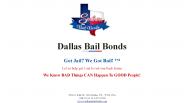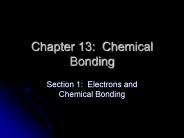Covealent Bonds PowerPoint PPT Presentations
All Time
Recommended
Physical Science Chapter 7: Atoms and Bonding ... Bonding
| PowerPoint PPT presentation | free to view
Unit 4 Bonding Knowing how many valence electrons an element has tells you what type of ion it tends to form. Several ways to tell: Electron configuration Blocks (s,p ...
| PowerPoint PPT presentation | free to view
COVALENT BONDING Chapter 16
| PowerPoint PPT presentation | free to view
Chemical Bonding Chapter 8 Sections 1-8
| PowerPoint PPT presentation | free to view
Chemical Bonds Three basic types of bonds: Ionic Electrostatic attraction between ions Covalent Sharing of electrons Metallic Metal atoms bonded to several other atoms
| PowerPoint PPT presentation | free to download
Chemical Bonding Chapters 8 and 9
| PowerPoint PPT presentation | free to view
Covalent Bonding Sch3u1 General Panet HS
| PowerPoint PPT presentation | free to download
Unit 4: BONDING Why do elements form bonds????
| PowerPoint PPT presentation | free to download
types of chemical bonds ionic bonds covalent bonds hydrogen bonds metallic bonds
| PowerPoint PPT presentation | free to download
Southern Bail Bonds Dallas provides felony, misdemeanor and traffic related bail bonds for Dallas County. We know BAD things CAN happen to Good People! We provide fast, courteous and professional service for all your bail bonds needs. Bail bonds service areas include Cedar Hill, Lancaster, DeSoto, Duncanville, Grand Prairie, Dallas, Mesquite, Garland, Richardson and Irving, TX. Contact info: Southern Bail Bonds 3936 S. Polk St. #110 Dallas, TX 75224 214-372-2500 https://southernbailbonds.com
| PowerPoint PPT presentation | free to download
Chapter 9 and 10 Bonding and Molecular Structure Valence and Core Electrons Valence Electrons electrons that participate in bonding Core Electrons electrons ...
| PowerPoint PPT presentation | free to download
Chemical Bonding
| PowerPoint PPT presentation | free to download
Chapter 05 Bonds & Valuation * Hypothetical Treasury Yield Curve Bankruptcy Bankruptcy alternatives:: Reorganization Liquidation Typically, a company wants ...
| PowerPoint PPT presentation | free to view
Chapter 9 Chemical Bonding * Mg ions and oxide ions are smaller than K ions and Cl ions. Also, Mg and O have 2+ and 2- charges, respectively. K and Cl only have ...
| PowerPoint PPT presentation | free to view
BONDING AND GEOMETRY Unit 8 Chemistry
| PowerPoint PPT presentation | free to download
Unit 11: Chemical Bonding Chemical Bonding Overview Chemical Bond: attractive force is between the nucleus of one atom and the valence electrons of another atom.
| PowerPoint PPT presentation | free to view
Chemical Bonding and Molecular Structure Ionic vs. covalent bonding Molecular orbitals and the covalent bond Valence electron Lewis dot structures
| PowerPoint PPT presentation | free to view
Covalent Bonding Orbitals Adapted from bobcatchemistry Resonance Benzene: The bonds remain centered (on the plane) between C atoms. Resonance Benzene: The p ...
| PowerPoint PPT presentation | free to download
Chapter 9 Chemical Bonding Theories Valence Bond Theory: Uses Lewis Structures Bonds form using shared electrons between overlapping orbitals on adjacent atoms.
| PowerPoint PPT presentation | free to download
... we can see and shape metal in so many different ways? Metal can be shaped because it contains a special bond called a metallic bond.
| PowerPoint PPT presentation | free to download
chemical bonding ionic bonds covalent bonds hydrogen bonds metallic bonds ionic bonding ionic bonding ionic bond formation ionic bonding ionic bonding metals will ...
| PowerPoint PPT presentation | free to view
Title: 6-1 Introduction to Chem Bonding Author: Todd Zerger Last modified by: teacher USD395 Created Date: 1/7/2003 3:23:10 PM Document presentation format
| PowerPoint PPT presentation | free to download
Molecular Geometry and Bonding Theories Brown, LeMay Ch 9 AP Chemistry Monta Vista High School Ch 9 PS #8, 10, 16, 20 (and draw overall dipole moments), 30, 34, 36 ...
| PowerPoint PPT presentation | free to download
Title: CHEMICAL BONDING Author: J. Kotz Last modified by: you Created Date: 3/19/1999 2:56:56 PM Document presentation format: A4 Paper Other titles
| PowerPoint PPT presentation | free to download
Covalent Bonding Chemistry Lesson #1 * * * * * * * * * * * * * * * * * * * * * * * * * * * * * * * * * * * * * * * * * * * * * * * * * * * * Electronegativity ...
| PowerPoint PPT presentation | free to view
If you need McKinney bail bonds, Collin county bail bonds then our company delta bail bonds can help you today and we are recognized for our fast and reliable work.
| PowerPoint PPT presentation | free to download
Unit 2: Bonding Review Questions Pg. 137 #3,4,6-14, 16, 19, 21, 22, 25-29, 31, 34-39, 41, 43, 47, 48, 51, 57, 60 brdebenham@cbe.ab.ca Review Questions Pg. 137 #3,4,6 ...
| PowerPoint PPT presentation | free to download
9.5 An Introduction to Metallic Bonding ... but not as solids Covalent Bonding Involve the sharing of one or more PAIRS of electrons between atoms of nonmetallic ...
| PowerPoint PPT presentation | free to download
Chemical Bonding and Molecular Geometry Lewis Symbols and the Octet Rule Ionic Bonding Covalent Bonding Molecular Geometry Covalent Bonding The ability of an atom in ...
| PowerPoint PPT presentation | free to view
Ch. 8 Covalent Bonding Pre AP Chemistry
| PowerPoint PPT presentation | free to view
Chemical Bonding Chemical Bonds are the forces that hold atoms together in compounds Ionic bond Covalent bond Metallic bond Polar Covalent bond Nonpolar Covalent bond ...
| PowerPoint PPT presentation | free to download
Chemistry, The Central Science, 10th edition Theodore L. Brown; H. Eugene LeMay, Jr.; and Bruce E. Bursten Chapter 8 Concepts of Chemical Bonding
| PowerPoint PPT presentation | free to view
Chapter 6. Bonds, bond prices and interest rates Bond prices and yields Bond market equilibrium Bond risks Bonds: 4 types zero coupon bonds e.g. Tbills fixed payment ...
| PowerPoint PPT presentation | free to view
Ionic, Metallic and Covalent Bonding Writing and Naming Formulas good conductors of heat and electricity; electrons mobile delocalized electrons interact with light ...
| PowerPoint PPT presentation | free to view
Multiple Bonds ... 2. Find the total number of electrons available for bonding. ... Shared bonding orbitals are pushed slightly together by lone pairs ...
| PowerPoint PPT presentation | free to view
Chapter 8 Covalent Bonding General Chemistry I T.ARA 1. The Continuum Covalent Polar Ionic Covalent - electrons shared - electrons shared ...
| PowerPoint PPT presentation | free to view
Chemical Bonding I: The Covalent Bond Lewis dot symbols The covalent bond Electronegativity Writing Lewis structures Formal charge and Lewis structure
| PowerPoint PPT presentation | free to download
Investing in Bonds and Other Investments Why Consider Bonds? ? Bonds reduce risk through diversification. ...
| PowerPoint PPT presentation | free to view
Chapter 8 Concepts of Chemical Bonding Chemical Bonds Three basic types of bonds: Ionic Electrostatic attraction between ions Covalent Sharing of electrons Metallic ...
| PowerPoint PPT presentation | free to view
Chapter 5 Bonds, Bond Valuation, and Interest Rates * * Bond Spreads, the DRP, and the LP A bond spread is often calculated as the difference between a ...
| PowerPoint PPT presentation | free to view
Mortgage bonds. A mortgage bond is a bond secured by a lien on real property. Eurobonds ... bonds, issued in a country different from the one in whose ...
| PowerPoint PPT presentation | free to download
Chapter 10: Chemical Bonding II: Molecular Shapes, Valence Bond Theory, and Molecular Orbital Theory 10.1 Artificial Sweeteners: Fooled by Molecular Shape (Suggested ...
| PowerPoint PPT presentation | free to view
Both methods amortize the same total amount of discount over the life of the bonds. ... The firm uses straight-line amortization. ...
Measuring Bonds Payable and Interest Expense ... The bonds mature in 10 years and interest is paid semiannually. The market rate is 12% annually. Are Harrah's ...
A bond, in its basic form, a plain vanilla bond is a type of loan. An investor takes his or her money and temporarily lends it to the bond issuer. In exchange, the investor receives interest income at a predetermined rate (the coupon rate) and at predetermined times (the coupon date). The bond has an expiration date (the maturity date) at which point the stated par value of the bond must be returned.
| PowerPoint PPT presentation | free to download
Why do atoms bond? 48.64g C 8.16g H 12.01 g C 1 mole C = 4.050mol C 1.008 g H 1 mole H = 8.095 mol H 43.20g O 15.99 g O 1 mole O = 2.702 mol O 2.702 mol 2.702 mol 2 ...
| PowerPoint PPT presentation | free to view
Chapter 7. Bond Valuation. 2. KEY CHARACTERISTICS OF BONDS ... Which type of bond would be paid first in the event of bankruptcy? ...
BOND PRICING Review of Basic Principles & Another Way of Looking at Bond Prices Basic Present Value/Future Value More General Relationship Example i=6% p=1 n=5 PV=100 ...
| PowerPoint PPT presentation | free to view
CHAPTER 7 Bonds and Their Valuation Key features of bonds Bond valuation Measuring yield Assessing risk What is a bond? A long-term debt instrument in which a ...
CHAPTER 7 Bonds and Their Valuation Key features of bonds Bond valuation Measuring yield Assessing risk Suggested problems on pages 224-226: 7-1 through 7-10 (all 10 ...
Bonds and Their Valuation. Key features of bonds. Bond valuation. Measuring yield ... You may invest in either a 10-year bond or a series of ten 1-year bonds. ...
What is a bond? ... Borrowers are willing to pay more, and lenders require more, for callable bonds. ... Semiannual bonds. Multiply years by 2 : number of ...
Most bonds have a deferred call and a declining call premium. Effect of adding a call provision ... The value of a premium bond would decrease to $1,000. ...
Normally, if a bond is called, the bondholder is paid a premium over the face ... of $964.54. The bond is callable in one year at a premium of 3% over the face value. ...
Bond valuation The application of the present value concept Today s plan Review of what we have learned in the last lecture Interest rates and compounding Some ...
Yields on longer term bonds usually are greater than on shorter term bonds, so the MRP is more affected by interest rate risk than by reinvestment rate risk.










































![Chapter 10: Chemical Bonding II: Molecular Shapes, Valence Bond Theory, and Molecular Orbital Theory 10.1 Artificial Sweeteners: Fooled by Molecular Shape (Suggested Reading) 10.2 VSEPR Theory: The Five Basic Shapes [10.1] 10.3 VSEPR Theory: The PowerPoint PPT Presentation](https://s3.amazonaws.com/images.powershow.com/4815694.th0.jpg)













